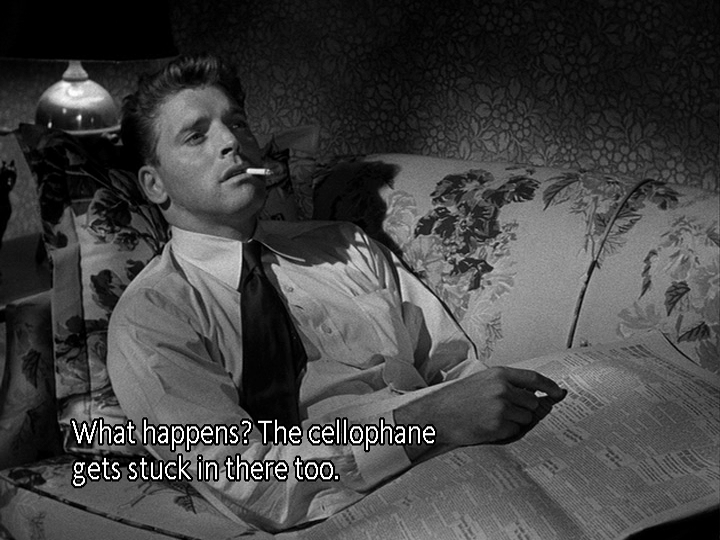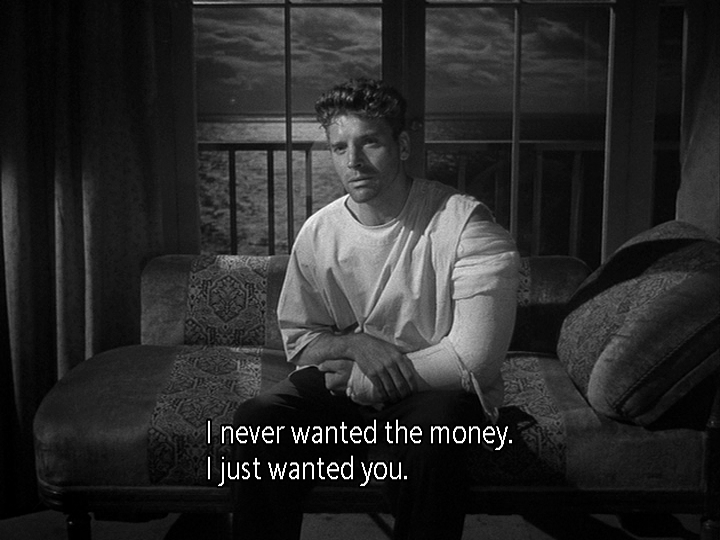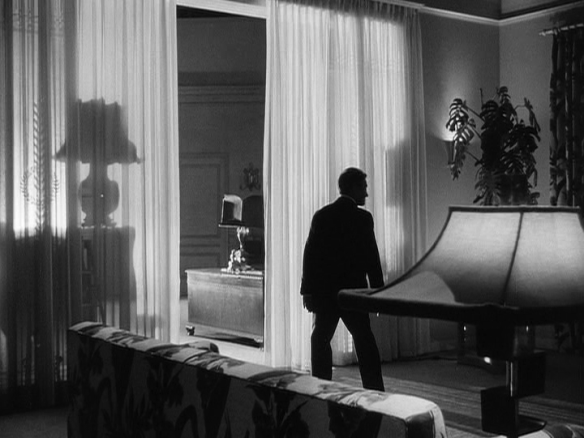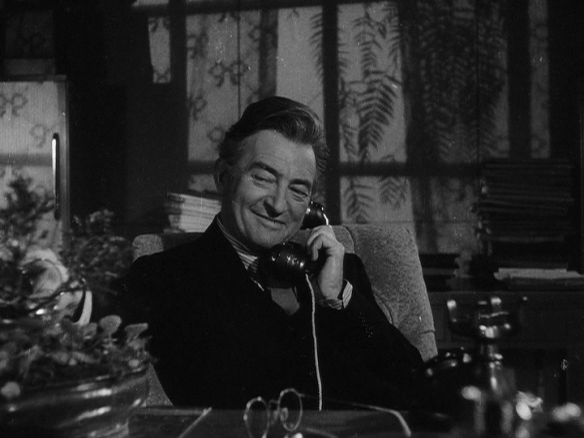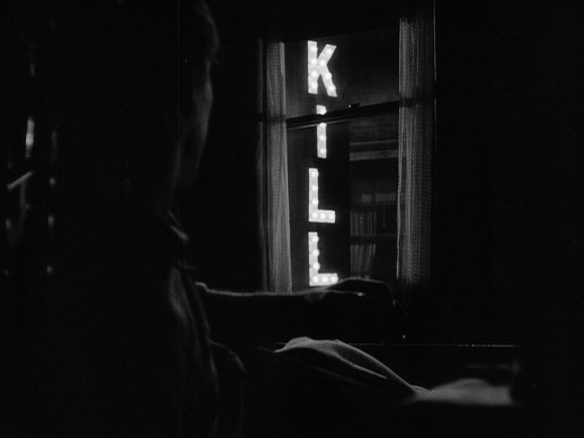 Decoy is a movie of the dead.
Decoy is a movie of the dead.
Honestly, the more I think about it, this movie is a Jacobean revenge tragedy wearing a fedora. It’s Lady Macbeth in a mud-spattered trench coat.
Over the course of this film’s action-packed 76-minute runtime, no less than two men essentially walk out of their graves to get what they want. The whole story is framed by a voice-over slipping into the beyond, but not spoken by a deadman like Joe Gillis, but by an evil woman whose life force is rapidly ebbing away.
That’s right—the femme fatale is… our protagonist.
In this movie, life is cheap and death is nasty, painful, and pointless. Crazy, farfetched conceits—like chemical resurrection and a map to a buried treasure—furrow the unreal story world of Decoy. It’s one bad trip.
Produced for a song at Monogram and directed by the obscure Jack Bernhard, Decoy takes the bizarro, jigsaw plot style of the Poverty Row studio’s often incoherent oeuvre and spins it into something truly extraordinary.

At once linear and all over the place, at once inevitable and luridly surprising, this film galvanizes everything warped and gorgeous about horror, sci-fi, trashy crime literature, and the legit noir canon into a dark, relentlessly suspenseful parable.

With a faint pulse of fatalism where a healthy moral might’ve been, this beautiful freak, we recognize, is a kind of pulp fable, a skid-row myth that resonates far beyond the confines of its characters and plot. It makes me think of the Greek word phobos, which refers not so much to ordinary fear (as in phobia) as to a more cosmic species of dread, associated with bloody, harrowing tragedy.
But I’m getting ahead of myself. As I mentioned, the wacko story is told in flashback by Margot Shelby, girlfriend of vicious mobster Frankie Olins who robbed an armored car, killed the driver, and made off with $400,000—only to get nabbed by the cops. Before getting caught, however, he managed to stash the loot in a location known only to him.
Sent down the fast track to the gas chamber, Frankie refuses to tell where to find the money as long as he’s going to die. Well, being the resourceful dame she is, Margot happens to know of a chemical, called Methylene Blue, that can revive an executed man. Personally, I’m surprised that the smell of her perfume alone couldn’t do it.

With the help of her main squeeze, Vincent, another racketeer, Margot seduces a naïve prison physician, Dr. Craig. They hijack the body and bring Frankie back from the edge of that Unknown Country, just long enough to draw out a map to where the loot is buried.
All along the way, a basically decent tough-guy cop, Sergeant Joe “Jojo” Portugal lingers around Margot, drawn in by a mixture of disgust and attraction, and attempts to unravel her scheme.

How do I begin to count up the ways I love this movie? I won’t try, but for starters, the camerawork impressed me by aligning the spectator with the point-of-view of the dead and dying. The first post-credits shot of the movie has the hemorrhaging, gut-shot Dr. Craig washing his shaking, bloody hands in a gas station sink and looking in a mirror. From the camera’s perspective, we’re looking in the mirror, seeing him as ourselves.



Likewise, when Frankie Olins succumbs to the cyanide gas in the State of California’s death house, we “die” in his place. We look through the glass at the stony gallery of spectators who’ve come to attend his execution—also a kind of parallel movie theater audience, drawn in by death as a spectacle.


As tendrils of grey vapor swirl in front of our (and Frankie’s) eyes, the angle of the shot torques and falls into black. When Frankie comes back from the dead, we assume his perspective once again as his blurred vision slowly focuses on Dr. Craig.



Thanks to these creepy subjective touches, Decoy stands out as a rare film noir that never loses track of the real-life stakes of its plot (the girl, the gun, the money) while taking a dip into the swampy pool of metaphysics. It is both gritty and surreal, corporeal and ethereal.
The dialogue, in particular, suggests this strange tug-of-war between the earthly and the unearthly. When noir has a sense of humor, it’s usually the trench humor of Hamlet’s gravediggers. Decoy doesn’t disappoint with its two bickering prison morgue attendants, situated in a long line of morbidly funny, quirky tertiary noir characters.
Immediately after Frankie Olins departs this life in the gas chambers, a shot tilts down from a clock to reveal one of the attendants cracking himself up by reading the dictionary. He happens to be spelling out (as in, “D-I—‘die’…”) and reading the word “dichotomy.”

Although he mispronounces this piece of semantic pretension, the fellow still exclaims, “What a beautiful word!” The beauty of a signifier without a signified, of a string of symbols without meaning, is something I can definitely relate to. Perhaps something is always most lovely to us when we don’t understand it. But that’s also when that alluring something is at its most dangerous—hence the lethal charms of the inscrutable femme fatale.
Dichotomies breed contention, division, conflict—I mean, it’s not a particularly positive word. Certain schools of thought strive to eliminate all notions of duality as harbingers of discontent. Yet, this silly morgue attendant considers the word beautiful (and it is indeed) because of its surface qualities only.

Noir, to a certain extent, revolves around this fatal error. Characters make the assumption that what something looks like, it must be in reality. They jump to the conclusion that a hidden thing, “the great whatsit,” or the chest of money in Decoy, is to be desired and not avoided like a toxic temptation. Interestingly enough, dichotomy can technically refer to that stage in a planet or celestial orb’s waxing or waning when it is half illuminated, half in darkness, half seen, half concealed.

What is film noir, if not a genre that stretches many dichotomies to their furthest extent while placing them side by side? Darkness and light, death and life, innocence and guilt, good and evil, love and hate, rich and poor—these poles, these binaries structure the genre and remain locked in a tense embrace. A dichotomy (or any duality) brings pain, but, the morgue attendant is right without knowing it. Dichotomy is beautiful. Like our very unconventional protagonist, Margot.
She’s also our narrator—and you know a noir’s bound to be full of doom when the femme fatale is telling the story, for crying out loud! And telling it from her deathbed. In the first five minutes of the movie, she gets shot by a man’s she left for dead. When Sergeant Jojo arrives on the scene and carries her to a nearby sofa, she utters a line of sheer tragic lyricism: “Everything’s mixed up. What mixes things up, Joe?”
Like the flatfoot he is, refusing to grasp the larger implications of her question, Jojo replies, “Simple arithmetic,” echoing something she said to him earlier in the film. From there, she launches into her story—which Jojo mostly knows already. In this case, the act of telling serves as a catharsis, an unburdening between her and Jojo.



However—and this is key—Margot doesn’t betray a modicum of remorse or apology. The awkward angle above, her point-blank stare, and the feverish beads of sweat on her brow inform us that Margot isn’t ’fessing up. If anything, she’s bragging. “I wanted money. And Frankie Olins had it,” she explains.


This might be a good place to mention that noir dialogue takes on a whole new life in Margot’s mouth because of actress Jean Gillie’s British accent. She gives every word of hardboiled, slang-rhythmed speech an immediate otherness, a quality that makes the audience more aware of the genre’s off-kilter poetry. Just the way she pronounces “Methylene Blue” makes it sound like a Tennyson heroine rather than an exotic chemical. Although her voice-over dissipates as the story unfolds, her personality prevails. Make no mistake—it’s her story.

Like many a femme fatale, she comes from grungy poverty, an English mill town where she learned to play for keeps. When the doctor she’s seducing suggests that they call off the plan and live simply and honestly off of his charitable medical practice in the slums, she gives him a reality check:
“Reality? What do you know about reality? You like the clothes I wear, don’t you? You like to smell the perfume I use. You like that, don’t you? That perfume costs seventy-five dollars a bottle! Seventy-five dollars! That’s as much as you earn in a week sopping up runny noses. A bottle of perfume—that’s our reality.”

Ouch! In one little rant, she demystifies her dewy glamour and yet becomes even more powerful through a crystallized fragment of logic. Perhaps it’s just because I’m a woman with expensive tastes, but I can’t fight back a tremendous feeling of edification when she rips into his moral high ground like that.
We see that only one thing scares Margot and that’s poverty, especially in an interesting scene during which she walks through a shabby part of town to visit Dr. Craig’s office. In a long take, she walks past a cheap set, a street of restaurants, laundries, sordid little buildings (that I’ve seen in probably half of the Monogram flicks I’ve ever watched).

Children are playing in the street—but whereas children usually signify hope or innocence in films, these little tykes only get in Margot’s way, throwing their stickball in front of her and rushing around in front of the camera. She doesn’t even turn her head to look at the kids, just stops a moment when a little boy rushes in front of her, then coldly goes on her way, wrapped in mink in the midst of bare subsistence. We understand only later that her desire to avoid the children stems from the fact that they remind her of her own childhood. As she blurts out to Craig,
“If I had never seen it, I still could have described it because that street runs all over the world. I know because that’s the street I came from: 6000 miles from here in a little English mill town. But it’s the same rotten street, the same factories, the same people, and the same little gray-faced children!”

That’s just one brilliant, thematically rich scene in this noir gem. There are too many more to describe, which is probably why this blog post is epically long. Seriously, if you read it all, you should get a drink on the house. You’ll probably need one.
Oh, and please note, beyond this point, major spoilers lurk. Beware.
I also have to applaud the tension of the reanimation scene that strongly recalls Frankenstein’s “IT’S ALIVE!!!” coup de théâtre. A lot of build-up… dials, respirators, heart monitors and suddenly a cyanide-gassed murderer sees, moves, and walks again, his muscles slack and wobbly as a newborn’s.

His eyes bulging and unfocused, the dead man opens the blinds, looks out at the nocturnal city, lights a match, stares in horror at the lick of flame on the match, and grunts, “I’m… alive,” before collapsing into tears.


Watching this big, prune-faced tough guy being medically reborn sends shivers up my spine, especially since no one cares about heinous killer Frankie Olins. All they want is to know where he hid the dough.
The scene isn’t a resurrection; it’s an interrogation. Life and death bend to the service of mercenary pursuits.

No sooner does Frankie reluctantly draw out a map to the treasure, then he decides he wants some back-from-the-dead sugar from the lovely Margot. Horrified, she backs away from her reanimated squeeze. I can only describe this scene as ultra-noir. It’s so morbid and creepy and wonderful and twisted. With one well-placed shot from Vincent, Frankie dies for the second time in under an hour.

If I have any advice to you all, it’s this: Don’t kill a dead man. It’s plain bad luck.
A moment later, Jojo shows up at the Doc’s office and Decoy takes the famous hallway scene from Double Indemnity and blows it up to a logical extreme. While Dr. Craig improvises some excuses about Olins’ missing body for Jojo’s benefit, Margot, her lover, AND the dead body cram into a tiny medical supply closet… while Vincent points the gun at Jojo, ready for action. It’s a master class in pulp suspense with the promise of violence hanging thick in the air, like the smell of antiseptic in a doctor’s office.

Most of the second half of the film takes place in a car, as Vincent, Margot, and Dr. Craig hit the road to find the loot. And, lest I forget, this film contains one scene that, I swear, I have no idea how they got it past the censors. It’s that unrepentantly brutal.
Because Margot runs over Vincent. She asks him to fix a tire. He does so. Just as he’s finishing, we see him stand up. We see Margot’s face glow with diabolic resolve. Then—WHAMMO! A blur and a shriek and he’s dead.

Okay, so here’s where most films noirs might dissolve to the following scene, the continued search for the treasure. Nope! Instead, we get damn long takes of Margot skipping back and forth between the car in real time, as she puts the tire-jack back in the trunk. The camera pans back and forth to follow her movements while her coat billows around her in the night breeze.
The lack of ellipses and the insistence on showing the logistical aftermath of Margot’s crime with detached observation makes the brutal, sudden murder seem all that more real and shocking. It’s not a just cinematic event, it’s something that happened, and has to be cleaned up afterwards.


The long takes ensure that we’re sewed up in the moment, we’re there with her, as time elapses in a continuous space. There are a few match-on-action cuts, when she pulls the treasure map out of Vincent’s coat pocket, but even then, the strange high angle and the way Margot’s head bobs in and out of the frame suggest both the sordidness and the matter-of-fact necessity of what she’s doing. And then they’re back on the road, hunting down the treasure.
Just when you thought the movie couldn’t get more nightmarish, it does. When Margot finds the treasure spot, she sinks to the ground and starts clawing, as the camera tilts up to a drunk and delirious Dr. Craig holding a sort of sickle-machete over his head.



He brings the weapon down—initially we think he’s going to brain Margot!—and proceeds to hack away at the earth where the treasure’s supposed to be. Meanwhile, Margot keeps on cackling, whipping herself up into a frenzy over how many people they killed for the treasure. And then she shoots Craig, grabs the casket, and runs giddily back to the car like a little girl coming home from a candy shop.


Now for the big spoiler. After Dr. Craig finds his way back into town, shoots Margot, and dies, Jojo opens the treasure chest over Margot’s dead body. There’s one dollar in it and a letter from Frankie Olins bragging that he leaves his loot “to the worms.”

So, the “decoy” referred to by the movie’s title is the phony treasure, planted by Frankie Olins to keep anyone but him from benefitting from his ill-gotten gains. I must confess, when I first picked up Decoy, my assumption was that it was going to be about an undercover agent or a police sting. In fact, the title was announcing a twist ending all along, right under my nose!

Usually the first part of a movie we come into contact with is a title, and they’re often not very revealing. Well, this one blows the movie’s whole secret. How’s that for a clever meta-filmic joke, a joke you only get after the whole gruesome spectacle has splattered across the screen? I suspect that you don’t realize what your own life is about until it’s over—if then—and Decoy follows this bitingly ironic path.
I should note, though, if this movie has a weakness, it’s some of the acting. We get convincing performances from old character actor stalwarts Sheldon Leonard (the bartender Nick in It’s a Wonderful Life) as Jojo and Robert Armstrong (who played the Merian C. Cooper surrogate role in King Kong) as Frankie Olins. However, Dr. Craig and Vincent come across awkward and wooden at times.
But, to make up for that, Jean Gillie, who only made a few movies and died at the absurdly young age of 33, inhabits the role of a ruthless gangland mistress so totally that you can practically feel the touch of her powdered, perfumed, silken skin—as she chokes the life out of you. And underneath all that tough, glossy exterior lies… a great big void where her heart should be. She litters her path with broken dreams and gunshot wounds. I’d also point out that she was married to Decoy’s director, John Bernhard, but they were divorced shortly after—rather like a Poverty Row version of those femme fatale-director pairings, Orson Welles and Rita Hayworth and Nick Ray and Gloria Grahame. In all three cases, the unhappy unions produced wildly beautiful films noirs.

I can’t stress this enough about Gillie’s Margot Shelby: this is one hard dame filling those bejeweled espadrilles, so hard that she doesn’t plan on any man exiting her life intact. I nominate her for the title of Film Noir’s Baddest Chick and we all know that’s real bad. She could make Phyllis Dietrichson look like a Sunday school teacher. At least Phyllis goes soft at the end, which is more than you can say for Gillie’s wholly rotten femme fatale.
In probably my favorite moment in a movie full of great moments, Margot, about to breathe her last, surrounded by policemen, sweetly coos to Jojo, asking him for a dying kiss. Clearly attracted to her since the get-go, Jojo cranes in. You can see his thought process, “Well, she’s dying, huh? It’d be wrong NOT to get some borderline necrophiliac lovin’…” whereupon Margot cackles in his face!

Right there, in her genuine enjoyment of Jojo’s humiliation, we see the essence of the femme fatale whose ultimate goal in life is to consume and destroy as many others as possible before she herself combusts. In a world where life is unpleasant and imminent death hangs over everyone like a pall, Margot’s drive to dominate makes us admire and respect her, because of the unadulterated wickedness and willpower of her nature. Then she dies. I love film noir, but I must confess that many an example of the genre dissolves into sentimentality at the last minute, so I found such an unflaggingly harsh death scene refreshing.
A film like Decoy means so many things. For one, it’s a testament to what can be done with very little, an inspiration to low-budget filmmakers. It also tells us why Jean-Luc Godard dedicated Breathless to Monogram—because cheap, raw, yet luminescent films noirs like Decoy shaped the vision of the next generation of directors much more than the ruffled, pretentious fare that big Hollywood studios were releasing as prestige problem pictures. However, regardless of its impact, Decoy deserves to be remembered in and of itself as a taut story that entertains, even as it unravels a trail of grim developments that make us squirm in our seats at the prospect of our own mortality.

Every now and then, I get to the point where I (rather arrogantly) think I’ve seen every movie worth seeing that exists within the confines of my interests. And I despair. And then I find a movie that hits me like a tender blackjack to the base of the skull and forces me to realize all over again what it means to watch a movie and be shocked and stunned by its audacity. Decoy is one of those movies for me. I think it might be for you too.
So dig it up. I dare you.



